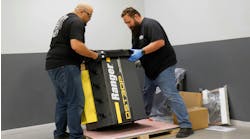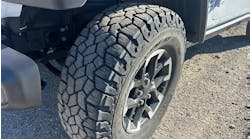The main driver of air system demand on a commercial vehicle is the number and size of the actuators on the brakes, as well as how often they are actuated. However, vocational trucks, bulk transport trucks, and severe duty trucks also require air to operate the working systems on these specialty vehicles. Furthermore, today’s more technologically advanced vehicles are placing increased demand on air systems.
“While the braking system itself hasn’t changed a whole lot in a generation, we are seeing more auxiliary functions that run off of air,” says Richard Nagel, director of marketing and customer solutions - air charging for Bendix Commercial Vehicle Systems. Bendix develops and supplies active safety technologies, air brake charging, and control systems for medium and heavy duty vehicles and trailers.
Examples of common truck features and components in need of clean, dry air include:
- Air ride suspension
- Trailer level height
- Fan clutches
- Automatic tire inflation systems
- Emission controls
- Automated manual transmissions (AMTs) with pneumatic shifters
“Going forward, commercial vehicles are seeing more automated functions such as electronic park that are also pneumatically controlled,” Nagel adds.
“All of these components and their related air lines, valves, and solenoids can fail due to poor air system maintenance,” says Erik Johnson, sales manager for Expello Air Products, manufacturer of the Expello Automatic Drain Valve.
Guarding against water contamination
As Bendix’s Nagel points out, the biggest issue with air brake systems over the past 50 years has been moisture damage resulting from water in the air tanks.
“Even in a well-operating system, water accumulation can occur in reservoir tanks,” says Gerry Mead, executive director of innovation at Phillips Industries, a manufacturer and supplier of parts for the trucking industry. That is simply the result of moisture being in the air. Thus, air tanks on both the truck and trailer must be monitored closely.
Expello Air's Johnson says daily draining of the wet tank will remove any contaminants that get past the air dryer.
“The use of automatic drain valves will remove all the oil and water from the wet tank while the vehicle is running – without placing the responsibility on the driver to manually drain the tanks which may be inaccessible anyway,” Johnson says. Expello Air's Automatic Drain Valve, for example, replaces the manual drain petcock on a tank. It purges water, oil, and dirt in one-second bursts every five minutes while the vehicle is on.
In addition to draining the tanks, regular inspection of the air dryer is important.
“The air dryer is the first line of defense against water and oil entering the air system,” Johnson says.
According to Nagel, dryers should be inspected every two to three months. Technicians should perform a manual blow-off and look for water and/or oil coming out of the tank.
Another thing fleets should think about is where the air dryer is mounted. The engine compartment and frame rail are two popular options.
“Many modern trucks have dryers with integrated multi-circuit protection,” Nagel says. “The governor, pressure protection valves, and purge valve are all part of the dryer. If the dryer is mounted on the frame rail, all of these components are subjected to road hazards, water, and sometimes salt. With these types of dryers, a potential failure mode is from valves extending from the bottom of the dryer. Every time the dryer exhausts moisture, that area of the dryer gets wet and begins to pick up dirt, which leads to corrosion. If that corrosion becomes severe enough, leaks can occur, and valves can begin to malfunction.”
Fleets should conduct a thorough visual inspection of the air dryer during the fall months.
“Dryers are often painted at the factory, but that paint eventually begins to peel off,” Nagel says. “If operating in a harsh environment, it’s okay to spray paint the exterior of the dryer housing because paint helps protect.”
Another action Bendix recommends fleets take is replacing the purge valve on the bottom of the dryer every couple of years.
“Internal check valves are also easy to change,” Nagel adds.
As for replacement of the dryer itself, lifecycles vary based on how and where a truck operates. That said, for normal over-the-road and regional applications, most cartridges last a couple of years, according to Nagel. On the other hand, severe duty applications might require cartridge replacement once or twice a year. Regular inspections will help fleets determine the precise time to replace a cartridge.
For tractor-trailer applications, fleets should not neglect the gladhands. Lines are used to supply a trailer with air to operate its braking system, allowing air to flow from the tractor’s air tanks through a gladhand and into the trailer’s tanks.
“Inspect gladhands regularly,” Phillips Industries’ Mead advises. “Failure to properly care for them allows moisture to penetrate the air system.”
Corrosion can be another big issue. Mead suggests using powdercoated or anodized gladhands in highly corrosive environments.
Mead offers some additional advice on how to properly care for gladhands:
- Replace if the small dimple on the connector plate is wore down
- Replace if heavy wear or corrosion is present on the detent plate; also look for loose or corroded rivets
- For gladhands with dust flaps, replace when flaps are missing or show signs of wear
- For gladhands with filter screens, replace when screens are damaged or congested with debris
- Regularly inspect rubber seals and replace them immediately when showing signs of wear
“Replacing gladhands every time you replace your air lines is another best practice,” Mead adds.
Compressor issues and oil in the system
Oil in the air system can present another set of challenges. According to Expello Air's Johnson, the compressor can be a major problem if not well-maintained.
“Failing compressors will add oil to the air,” Johnson points out. “This will foul the desiccant bed of the air dryer, allowing excess water and oil to enter the wet tank. If the wet tank is not drained daily, that water and oil can end up entering the rest of the air system.”
Johnson says an excessive amount of oil in the wet tank discharge indicates a problem with the compressor that should be addressed immediately. The key word is excessive.
“Fleets need to look at the air compressor and realize that all compressors, even brand-new ones, will pass some oil,” Bendix’s Nagel says. “If enough oil is passing, and when subjected to elevated temperatures, fleets can end up with significant carbon buildup at the discharge line – maybe enough that air will not pass.”
Given that longstanding challenge, air systems have been built to tolerate a certain amount of oil. Today’s controls, however, don’t have the same tolerance levels. Nagel says this is one reason why oil-coalescing filters are becoming more popular. Another reason is the increasing use of AMTs.
“Most modern trucks with an AMT have an air dryer with an oil-coalescing filter,” Nagel says. “This is a big change from a few years ago. Fleets must maintain air dryer cartridges just like they have been. But they must understand that if a dryer is equipped with an oil-coalescing cartridge, they need to replace it with an oil-coalescing cartridge.”
To properly diagnose and resolve compressor/oil issues, fleets can look at a few key areas. Oil on the outside of the compressor could simply trace back to leaky gaskets, lines, or fittings that need to be adjusted, or perhaps replaced. When it is evident that oil is leaking from the compressor itself, a bigger problem could be at hand. Ideally, a simple fix such as resealing the bottom cover plate could solve this. Worst case, the compressor needs to be replaced.
Excessive oil consumption can be a telltale sign of a faulty compressor. However, TMC Recommended Practice (RP) 630 says a host of other problems could also be the culprit:
- Restricted air intake
- Poorly filtered air inlet
- Restricted oil return to engine
- Insufficient coolant flow
- Contaminants not being regularly drained from system reservoirs
- Low or excessive engine oil pressure
- Excessive engine crankcase pressure
Of course, the issue could simply be a faulty compressor. However, RP 630 points out that the major cause of excessive oil consumption and premature failure is high compressor duty cycle caused by air system leaks. Vehicle system leakage should not exceed industry standards of 1 psi pressure drop per minute without brakes applied, and 3 psi with brakes applied.
Read more about how to test for leaks in a truck’s air brake system at VehicleServicePros.com/21029326.
Dealing with system leaks
According to Phillips Industries’ Mead, fleets should visually inspect air lines, especially during pre- and post-trip inspections. These lines can crack, chafe, or become loose due to vibrations, all of which can cause air leaks.
Vigilant inspections can help catch problems early. Smart specification can help avoid problems in the first place. Mead says fleets should choose air lines that have ultra-protective jacketing that offers enhanced abrasion, cracking, and chemical resistance.
In addition, Mead says something as simple as proper support placement for cables helps ensure the life of both cables and cable support springs.
“Ensure that your [cable] support mechanism is placed to allow full working length of coiled air lines, as well as to prevent cable damage from wrapped straight air lines and overstretching of the support springs,” Mead adds.
Telematics and diagnostics can also assist with leak detection and overall air system maintenance. For instance, Cojali, a European-based company, has developed a pneumatic braking system with electronic control. A roll stability program (RSP), developed for towed vehicles, incorporates constant monitoring of the system’s activity. The algorithms integrated in the diagnostic system allow fleets to determine faults in the early stages – such as air leaks. The RSP system also incorporates the onboard data recorder (ODR) functionality. ODR allows fleets to see how the system is being used in order to better schedule maintenance.
Despite all of these preventive efforts, there is still a chance leaks will occur. Air brake system leaks can occur at all connections, valves, gaskets, and fittings.
“Sometimes a leak is inevitable because materials naturally wear down over the course of a vehicle’s lifetime,” says Jack Kelly, vertical marketing strategist for Tracer Products, a manufacturer of automotive leak detection products.
“The problem with air systems today is that many manufacturers have gone to plastic hosing and quick couplers,” adds Mark Hawkins, manager of technical solutions for Redline Detection, a manufacturer of diagnostic leak detection equipment. “This has devastated the repair of the system because there are more joints, and thus, more leak points.”
Those plastic components can also get shaken loose when a truck travels down the road. This can cause small leaks to emerge – and existing small leaks to turn into big ones. That said, it’s the little leaks that often cause issues for a fleet.
“It’s not too often when there is one major leak that a technician can hear,” Hawkins says. “There are often three, four, or five smaller leak points that add up to a big problem. Technicians often don’t know where to look. They remember a previous repair they did and check there. But they are left scratching their head if that doesn’t solve the problem. I’ve seen leak points at virtually every joint in the system.”
“One of the most frustrating issues with air brake system repair is finding and repairing a leak, only to find out that there’s more than one leak in the system,” Kelly says. “Because air brake systems operate at high pressures and are reliant on many components working together, the chance of multiple leaks is very common.”
Technicians need modern tools to help locate leaks as quickly as possible.
“By using new technology, it can take a technician 15 minutes to find out if a system has a leak,” says Alex Parker, chief marketing officer and executive vice president for Redline Detection.
Redline’s Air Brake NanoLeak Finder features patent-pending technology that creates a unique vapor, referred to as Signature Air, that is injected into the vehicle’s air system.
“The nice thing is that a less experienced technician can connect the NanoLeak Finder to the truck’s air system to run an automatic, 15-minute ‘pass/fail’ check,” Parker explains. “That technician can continue doing other things while the system runs the check. If the system fails the check and a leak is detected, a more experienced technician could get involved at that point.”
Hawkins says it would be nice to simply utilize a modified smoke machine to find air system leaks. After all, Redline Detection has offered smoke machines for years.
“But the problem with air systems is that you can’t see the visual vapor particulate matter because the leaks are so small,” Hawkins points out.
Another alternative to a smoke machine is ultrasonic leak detection. Tracer Products’ Kelly says this is one of the fastest and most effective methods available. “A technician can scan an entire brake system with ease to confirm that all repairs have been successfully completed and that there are no additional leaks in the system,” Kelly explains.
Ultrasonic tools, such as the TP-9637L Marksman II from Tracer Products, convert and simplify inaudible sound into a natural, audible sound the human ear can identify.
“Think of it as an early warning system that detects problems before they result in major breakdowns,” Kelly says. “When used regularly, it reduces labor time and high-cost repairs.”
Regardless of which leak detection method is being used, Redline Detection’s Hawkins says fleets should inspect for air system leaks as part of a routine preventive maintenance schedule.
“Technicians can check for leaks when changing the engine oil or during routine 90-day inspections,” Hawkins says.
Like with most truck systems and components, good preventive maintenance is the key. With an air system, this includes maintenance of all vital system components, from the air compressor and dryer to the tanks, hoses, valves, and connectors.
“Whenever there’s a problem with the air system, fleets often want to replace the governor because it’s an inexpensive part and easy to change out,” Bendix’s Nagel says. “When a system isn’t building enough air, however, the governor is rarely the cause.”
Rather, the more likely cause is water, oil, or contaminants in the system, carbon buildup, corrosion, or system leaks – all problems the fleet can catch through good preventive maintenance practices.




